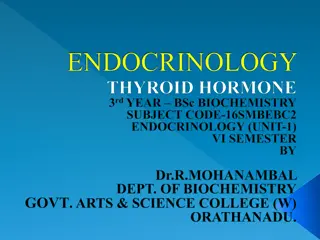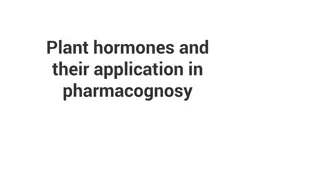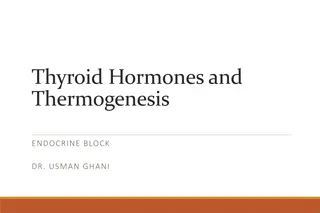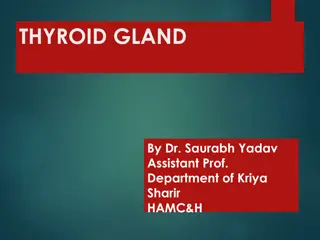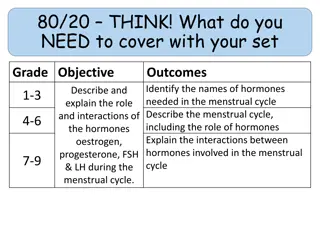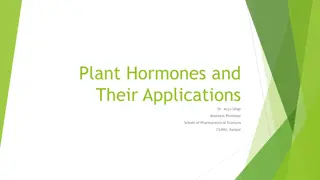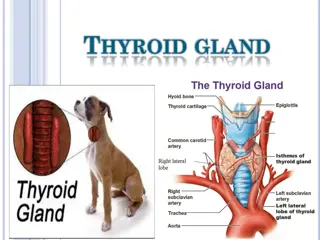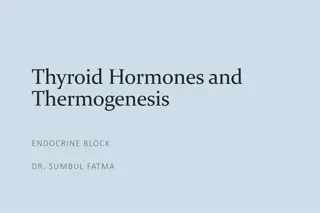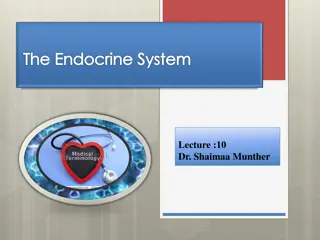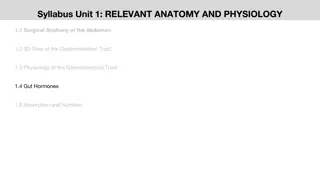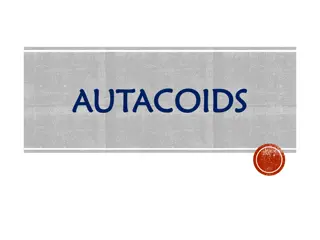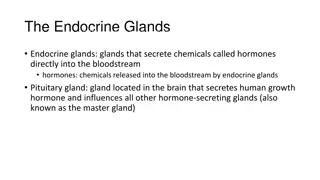Understanding Hormones and their Role in the Body
Hormones are chemical messengers that play a crucial role in regulating various metabolic functions in the body. They are transported through the bloodstream to tissues and organs, affecting processes like growth, metabolism, and reproduction. Some hormones have autocrine and paracrine effects in addition to their endocrine effects, influencing nearby cells or the cells that secrete them. The hypothalamus is a key part of the endocrine system, producing important neuropeptides like oxytocin and ADH. Hormones from the anterior pituitary gland, such as TSH, gonadotropins, somatotropin, prolactin, and ACTH, also have essential functions in the body.
Download Presentation

Please find below an Image/Link to download the presentation.
The content on the website is provided AS IS for your information and personal use only. It may not be sold, licensed, or shared on other websites without obtaining consent from the author. Download presentation by click this link. If you encounter any issues during the download, it is possible that the publisher has removed the file from their server.
E N D
Presentation Transcript
HORMONES (1)
HORMONES Chemical messengers of the body. They are transported to tissues or organs via blood circulation They work slowly but affect many metabolic functions.
In addition to endocrine effects, some hormones have autocrine and paracrine effects. Endocrine Effect: Affect a tissue far away from where the hormone is secreted Paracrine Effect: Affect the adjacent cell Autocrine Effect: It is the same hormone affects the cell that it is secreted.
HYPOTHALAMUS Endocrine Glands - - - - - - - - Hypothalamus Pituitary Thyroid Parathyroid Ovary Testis Adrenal Glands Pancreas Oxytocin ADH PRH TRH GnRH CRH GHRH Pituitary Anterior lob Posterior lob ADH Oxytocin GH FSH/LH TSH ACTH Prolactin Target Cell
. Hypothalamic Neuropeptides 1. Oxytocin - Stimulation of the contraction of smooth muscles during childbirth and lactation - Oxytocin is often given to speed up childbirth - It is important for milk to be released after childbirth.
2. ADH (Antidiretic Hormone- Vasopressin) - Effects kidney tubule cells - Provides the retention of filtered water from the kidneys - Concentrates the urine - Increases the permeability of the tubules to water - Causes blood vessels to contract - The most important factor controlling the vasopressin secretion is the osmolality of the blood.
2. ADH (Antidiuretic hormone- Vasopressin) Plasma osmolality Pituitary Diabetes nsipidus The pituitary gland produces insufficient ADH Urine amount increases ADH Water permeability of kidney collection channels Plasma osmolality
Anterior pituitary Hormones 1. TSH (Thyroid-stimulating hormone) 2. Gonadotropins (LH and FSH) 3. Somatotropin (GH) 4. Prolactin 5. Adrenocorticotropic hormone (ACTH)
Anterior pituitary Hormones 1. TSH (Thyroid-stimulating hormone) - Hypothalamus TRH Negatif feed back - - Pituitary TSH Thyroid hormones Thyroid Gland
.H 2. Gonadotropines (LH and FSH): - + - - Primary effects in women; egg development, implantation and normal growth of the fetus - FSH; - Stimulates the development of follicles in the ovaries and sperm in the testicles Hypothalamus GnRH - - Pituitary FSH, LH - LH ; . - It is effective on the production of steroid hormones. - Stimulates Leyding cells to produce testesterone and stimulates corpus luteum to produce progesterone in the ovaries. - The main stimulus for LH and FSH comes from GnRH Estrogen and progesterone Testesterone Testis and ovary
. 3. Somatotropin (GH): The main effect is to stimulate the growth of the organism Stimulates the growth of long bone and soft tissue. GH affects carbohydrate, protein and fat metabolism.
3. Somatotropin (GH): Reduces glucose uptake by muscle cells and adipose tissue Liver ..Gluconeogensis , glycogenolysis blood glucose levels Shift from glucose to lipids as an energy source Increases amino acid uptake of cells. It has anabolic effects on protein metabolism. Increases lipolysis in fat cells, increases the use of oils for energy GH secretion increases with GHRH. Somatostatin is secreted from the hypothalamus. Inhibits GH secretion from adenohypophysis
3. Somatotropin (GH): It modulates the activities of liver, kidneys, bone, cartilage, skeletal muscle and fat cells.
3. Somatotropin (GH): GH deficiency before puberty . short stature Over secretion before puberty . Gigantism After adolescence, GH excess thickening of long bones, facial contours become rough, feet and hands grow.
4. Prolactin - It is controlled by the PRH released from the hypothalamus. - Its level in the blood increases during pregnancy. - It causes the development of mammary glands in females. - It increases the synthesis of milk proteins and milk production. - It prepares the mammary glands for lactation during pregnancy, but there is no milk secretion. It provides lactation to start and continuity after birth.
5. Adrenocorticotropic hormon (ACTH): Hypothalamus CRH - Pituitary Cortisol- ACTH Adrenal glands
5. Adrenocorticotropic hormon (ACTH): Cushing syndrome: - Excessive production of ACTH is seen. - Abnormal cortisol release - Cortisol secreting tumor of the adrenal cortex - Mobilization of fats from the underside of the body, - Excessive storage of the chest and upper abdomen - Edema in the face - Purplish lines in subcutaneous tissues
Physicochemical Properties of Hormones Hydrophobic: Steroidal hormones Hydrophilic: Peptide hormones and Thyroid Hormones
Mechanism of action of hormones Hormones must bind with their original receptors to show their effects when they reach the target tissue / cells. Receptors are located in the cell membrane, cytoplasm or nucleus.
HORMONES; Hormone receptors are on the surface of the cell or inside the cell
Mechanism of Hormone Action- Receptor-Signal Transduction Steroidal structure hormones Aminoacid structure hormones Peptid (polypeptide) structure hormones
Action Mechanism of Steroid and Thyroid hormones Cell Membrane Glucorticoids enter the cell and activate cytoplamic or nuclear receptors. Activated receptors initiate the transcription of genes sensitive to glucocorticoids. The DNA binding region of the activated receptor has increased interest to the specific glucocorticoid response elements. Location of receptor: Cytoplasm/Nucleus Hormone-Receptor Interaction?
Mechanism of Hormone Action in polypeptide structure Second Messengers: DAG, Ca+2 , IP3, cAMP, cGMP Effector Molecule Adenilate cyclase, guanilate cyclase Protein kinases: PKA, PKC Locaction of Receptors: Cell Membrane 1. Channel-type receptors : Calcium channels 2. G-protein bound receptors : Glukagon, alfa adrenerjik receptors 3. Enzyme-type receptors (Tyrosine Kinase ): Insulin Receptors
REFERENCES The Endocrine System An Overview Susanne Hiller-Sturmh fel, Ph.D., and Andrzej Bartke, Ph.D, Vol. 22, No. 3, Alcohol Health & Research World1998 MONTGOMERY - CONWAY-SPECTOR-CHAPPEL, B YOK MYA OLGU SUNUMLU YAKLA IM, eviren: Nilg n Altan Lippincott s Illustrated Reviews Series Editor: Richard A. Harvey Biochemistry Denise R. Ferrier


